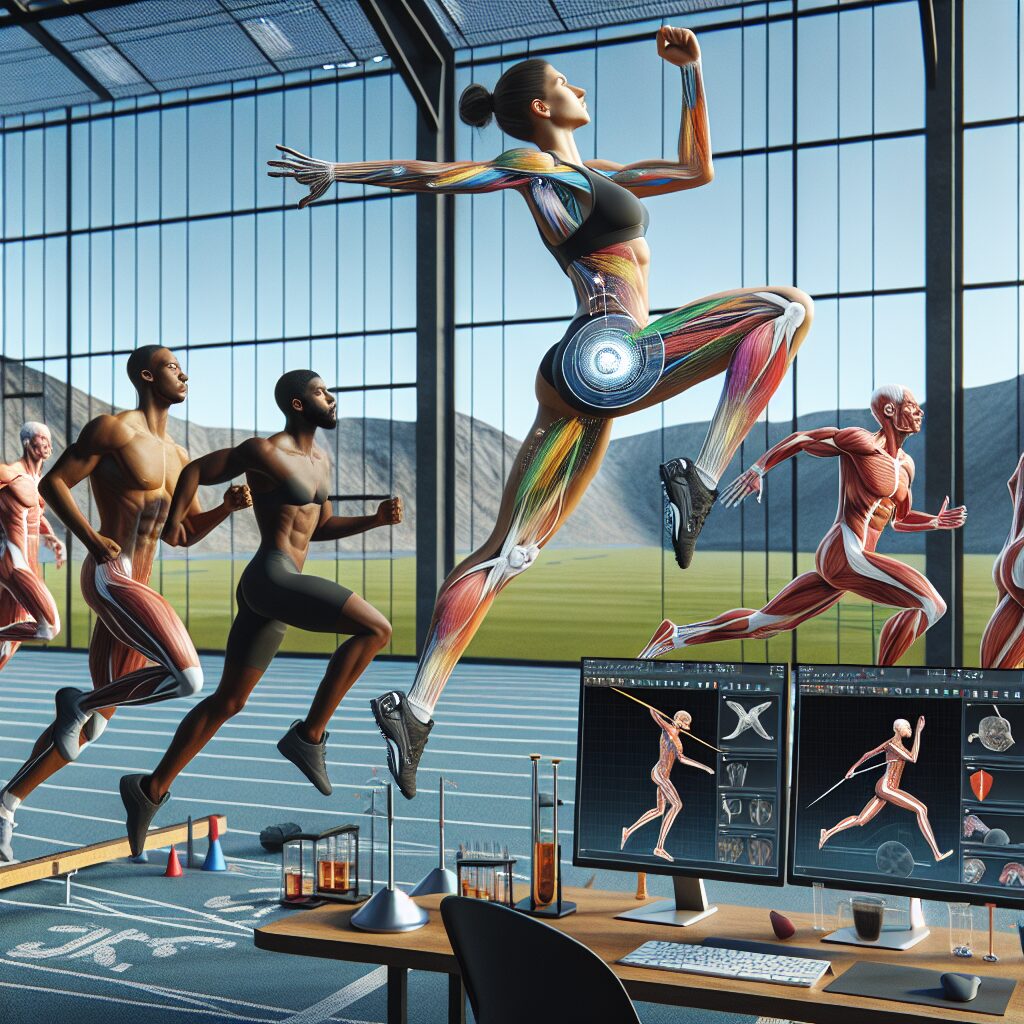Biomechanics Analysis of Athletes: Optimizing Movement
The field of biomechanics analysis is dedicated to studying the forces and movements of the human body, particularly in relation to athletic performance. By applying principles of physics and engineering, biomechanists seek to understand the intricate details of how athletes move and identify ways to optimize their performance. One unique fact to note is that biomechanics analysis enables a comprehensive evaluation of an athlete’s technique, not only in terms of power and speed but also in terms of injury prevention and efficient movement patterns. By delving deep into the biomechanics of athletes, researchers can unravel the secrets behind elite performances and help athletes unlock their full potential.
One key impact of biomechanics analysis is its ability to identify inefficiencies or improper movement patterns that may be hindering an athlete’s performance. Through advanced motion analysis techniques, researchers can capture and analyze the movements of athletes in great detail. This allows them to pinpoint specific areas where an athlete may be lacking in power, technique, or even experiencing excessive wear and tear on their joints. By identifying these issues, coaches and trainers can then implement corrective measures to improve the athlete’s overall performance.
In the upcoming part of this article, we will discuss the key takeaways from biomechanics analysis of athletes. This will include examining how biomechanics can be applied in various sports, the specific measurements and technologies utilized in biomechanical analysis, and the potential future developments in the field. By exploring these aspects, readers will gain a deeper understanding of how biomechanics can impact athletic performance and ultimately help athletes reach new levels of success. So, let’s dive into the fascinating world of biomechanics analysis and uncover its hidden potential.
Key Takeaways
1. Biomechanics analysis is a valuable tool that can optimize an athlete’s movement and performance by examining their body mechanics, muscle activation, and force distribution during different movements.
2. The use of advanced technology, such as motion capture systems and force platforms, allows researchers and coaches to accurately assess an athlete’s biomechanics and identify areas for improvement or injury prevention.
3. Biomechanics analysis can help athletes enhance their performance by optimizing their technique, improving their power output, and reducing the risk of injuries by identifying faulty movement patterns or imbalances.
4. By accurately assessing an athlete’s biomechanics, coaches and trainers can develop targeted training programs that focus on specific areas of improvement, such as muscle activation, joint stability, or range of motion, to maximize the athlete’s potential.
5. Biomechanics analysis is not only beneficial for professional athletes but can also be used in various sports settings, including rehabilitation, skill development, and injury prevention programs, to enhance performance and reduce the risk of injuries for athletes of all levels.
What is the Importance of Biomechanics Analysis in Optimizing Movement for Athletes?
Biomechanics analysis plays a crucial role in enhancing the performance of athletes by optimizing their movement patterns. By studying and understanding the mechanical principles and capabilities of the human body, biomechanics can identify areas of improvement and guide athletes towards more efficient and effective movement. Here, we delve into various aspects of biomechanics analysis and its significance in optimizing movement for athletes.
1. Kinematic Analysis: Assessing the Motion of Athletes
Kinematic analysis involves the study of motion without considering the forces that cause it. This analysis allows biomechanists to evaluate an athlete’s movement patterns, joint angles, and body positioning during various activities specific to their sport. Through techniques such as video recording, motion capture systems, and 3D modeling, kinematic analysis provides valuable insights into an athlete’s technique and helps identify areas that require improvement.
2. Kinetic Analysis: Understanding the Forces Acting on Athletes
In contrast to kinematic analysis, kinetic analysis focuses on understanding the forces that act on athletes during their movements. By using force plates, pressure sensors, and electromyography (EMG), biomechanists can measure the ground reaction forces, muscle activities, and joint torques experienced by athletes. This information aids in identifying suboptimal forces and loads that may lead to injury or inefficient movement. Kinetic analysis enables athletes and their coaches to make necessary adjustments and enhance performance.
3. Performance Optimization through Biomechanics Analysis
Biomechanics analysis plays a vital role in optimizing an athlete’s performance by identifying and resolving biomechanical constraints. By evaluating an athlete’s movement patterns and mechanics, biomechanists can develop personalized training programs that target specific areas for improvement. These programs may include strength and conditioning exercises, technique modifications, or utilization of specialized equipment. Through the implementation of biomechanics analysis, athletes can enhance their efficiency, power, and overall performance.
4. Injury Prevention and Rehabilitation
Biomechanics analysis is invaluable in identifying movement patterns or mechanical deficiencies that may contribute to injury in athletes. By detecting faulty mechanics or excessive loads on certain body structures, biomechanists can provide insights on injury prevention strategies. Furthermore, biomechanics analysis plays a vital role in the rehabilitation process, guiding athletes through proper movement mechanics and gradually restoring their capabilities while minimizing the risk of reinjury.
5. Sports-Specific Biomechanics Analysis
Biomechanics analysis is tailored to address the specific demands of different sports. Whether it’s analyzing the sprinting technique of a track athlete, the golf swing of a golfer, or the jumping mechanics of a basketball player, sport-specific biomechanics analysis provides coaches and athletes with detailed insights into their performance. By highlighting weaknesses or areas of improvement unique to each sport, athletes can refine their technique and optimize their movement to excel in their respective fields.
Guides for Optimizing Athlete’s Movement through Biomechanics Analysis:
- 1. How to conduct a comprehensive biomechanical assessment of an athlete?
- 2. Identifying and addressing movement inefficiencies through kinematic analysis.
- 3. Understanding ground reaction forces and muscle activation for optimizing performance.
- 4. Implementing personalized training programs based on biomechanics analysis results.
- 5. Utilizing biomechanics analysis for injury prevention and rehabilitation.
- 6. How sport-specific biomechanics analysis enhances performance in different athletic disciplines?
Frequently Asked Questions
1. What is biomechanics analysis?
Biomechanics analysis involves the study of human movement and the forces that act upon it. It helps in understanding how athletes can optimize their movement patterns to improve performance and prevent injuries.
2. How is biomechanics analysis beneficial for athletes?
Biomechanics analysis provides athletes with valuable insights into their technique, efficiency, and potential areas for improvement. It allows them to identify mechanical inefficiencies and make necessary adjustments to enhance their performance and reduce the risk of injuries.
3. What techniques are commonly used in biomechanics analysis?
Common techniques used in biomechanics analysis include motion capture systems, force plates, electromyography (EMG), and 3D modeling. These tools help to measure and analyze various aspects of an athlete’s movement, such as joint angles, forces exerted, muscle activation, and timing.
4. Can biomechanics analysis help in injury prevention?
Yes, biomechanics analysis can play a significant role in injury prevention. By identifying movement patterns that put excessive strain on certain joints or muscles, athletes can modify their technique to reduce the risk of injuries. It helps in developing personalized training programs that focus on optimizing movement patterns and correcting faulty mechanics.
5. How does biomechanics analysis impact performance optimization?
Biomechanics analysis allows athletes to fine-tune their technique to maximize performance. By studying the relationship between different variables, such as body positioning, force production, and timing, athletes can make adjustments that optimize their efficiency and power output. This, in turn, enhances their overall performance.
6. Can biomechanics analysis be used for injury rehabilitation?
Yes, biomechanics analysis can be instrumental in injury rehabilitation. By analyzing an athlete’s movement patterns post-injury, it helps in identifying compensatory movements or imbalances that may hinder their recovery. By addressing these issues, athletes can regain proper movement patterns and prevent future injuries.
7. Is biomechanics analysis only for professional athletes?
No, biomechanics analysis is beneficial for athletes of all levels, from recreational to professional. It provides valuable insights into individual movement patterns and helps athletes at any level optimize their performance and reduce the risk of injuries.
8. Does biomechanics analysis require expensive equipment?
While some advanced biomechanics analysis tools can be costly, simpler techniques, such as video analysis, can also provide valuable information. Many universities and sports facilities offer biomechanics analysis services that utilize various equipment and software, making it accessible to a wider range of athletes.
9. How often should athletes undergo biomechanics analysis?
The frequency of biomechanics analysis depends on various factors, such as the athlete’s goals, performance level, and any recent changes in their technique or training. Athletes may benefit from regular analysis initially to establish a baseline, followed by periodic assessments to track progress and make necessary adjustments.
10. Where can athletes find professionals who specialize in biomechanics analysis?
Athletes can find professionals who specialize in biomechanics analysis at sports science centers, universities, and private sports clinics. It is important to seek qualified experts who have experience working with athletes in the specific sport or activity.
Final Thoughts
Biomechanics analysis plays a crucial role in optimizing the movement of athletes. By understanding the mechanics of human motion and identifying areas for improvement, athletes can enhance their performance and reduce the risk of injuries. Whether it’s addressing faulty technique, maximizing power output, or aiding in injury rehabilitation, biomechanics analysis offers valuable insights that can make a significant impact on an athlete’s journey towards success.
Embracing biomechanics analysis as a part of training and development is essential for athletes who strive to reach their full potential. By seeking professional guidance and utilizing the tools and techniques available, athletes can unlock hidden improvements in their movement patterns and achieve new heights in their performance. Remember, optimized movement is a key ingredient for athletic success!




